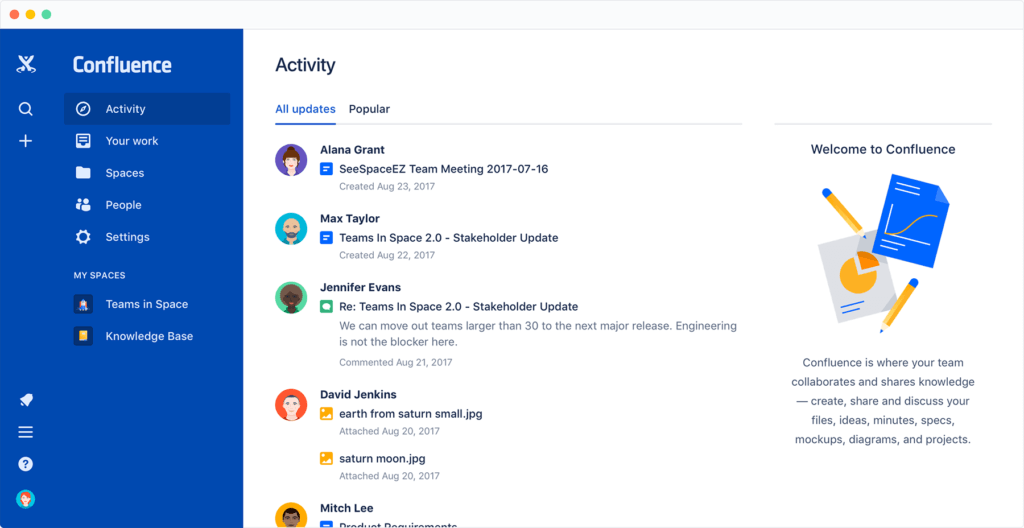Table of contents

Are you tired of the endless sprawl of documents across your organization? Do you need a tool for document management, knowledge sharing, and collaboration? Confluence may very well be the tool you’re seeking.
Confluence has been around since 2004 and is used worldwide by over 60,000 organizations. There are numerous use cases for Confluence, and it seemingly fits in with every department in your organization. Let’s clarify the confusion around the different use cases of Confluence and find out if it is the right tool for you.

Confluence is a wiki-like collaboration and information management tool developed by Atlassian. We say wiki-like because everyone is familiar with Wikipedia, a website based on MediaWiki, so it is easy to grasp what it could do.
Big teams gather and produce an endless array of information. In teams that don’t use a platform like Confluence, this knowledge base must be passed by word of mouth, which is inefficient and produces inaccuracies.
Unlike MediaWiki, Confluence is designed for enterprise collaboration and management, with some key features that large teams will find invaluable:
You can host Confluence in any of the typical choices afforded by software vendors targeting enterprise organizations. The easiest solution is SaaS, where Atlassian hosts and manages the software for you. Atlassian has a free cloud plan, which means that even if you intend to host it yourself, you can get to know the product before purchasing it.
You can host Confluence on IaaS or locally for a more involved solution. Regarding IaaS, you can easily host Confluence on AWS or Azure and retain significant control over configuration to adhere to your specific needs. Local hosting of Confluence requires higher maintenance but could be the right choice if you require tighter access management and data governance.
Confluence is a product that solves a wide array of problems across many potential fields. Any enterprise organization is bound to accumulate a wealth of knowledge that must be passed around between different teams and used to train new employees.
Engineering teams are most likely to use a technology-oriented tool like Confluence. Still, other departments, such as Marketing and Product Management, could benefit from having a shared knowledge pool, especially when you can cross-pollinate with other departments.
As a tool, Confluence has a set of features that trivialize specific use cases. Atlassian offers Spaces built from templates for several common uses, which makes for a fast setup:
Technical documentation – Writing technical documentation as a separate set of documents causes repetition, errors, and disjointed information. Confluence has features that prevent unnecessary repetition by making sentences, images, and other segments reusable.
Knowledge base – IT teams need quick and easy access to information when helping customers solve problems. Having a fully searchable knowledge base and quickly adding information to the knowledge base will allow your IT department to focus on the client.
Intranet – A central hub for your organization where users can be added without administration overhead helps everyone stay connected. Setting up a space for each team is a sound basis for an intranet.
Software development – The most evolved aspect of Confluence is the tools available for software development. With many templates to choose from, a software development team can get a head start on vicarious common topics such as:
While it’s true that Atlassian put a lot of thought into Confluence and the above use cases, it doesn’t mean that they are perfect solutions. How can you tell if Confluence is the solution for you?
There are many suitable applications for Confluence; here are some common ones.
Every organization, from the smallest to the largest, produces documents. When the number of records is small, it can be manageable to spread out across multiple Google Docs or Word files in a Dropbox. But as documents accumulate, they become increasingly challenging to maintain.
Confluence has various tools to help you manage documents, which is the process of storing, archiving, and retrieving documents. You can upload documents to Confluence and attach them to pages or create documents inside Confluence. You can have document trees, which help associate documents with concepts, departments, or teams. Confluence can also link documents to various stages in your workflow if you’re using Jira for product management.
Feedback loops and collaboration
Collaboration is a core feature of Confluence. Commenting and mentioning colleagues can all be done in real-time with multiple contributors. Feedback loops are essential to creating, maintaining, and improving documents. Collaboration features are critical when various teams or departments need to process, review and maintain these documents. They also enable higher productivity.
The Atlassian website has countless templates that can fit every need. There are templates for design, Business Strategy, Customer feedback interviews, Product Management, Human Resources, and many more. A short browsing of the templates will spark ideas for how to use Confluence across all your departments.
Atlassian may have adopted Confluence for nearly every document requirement, but that doesn’t mean it is the best tool for the job or even an adequate one. Here are some tasks for which Confluence may fall short.
As a developer, you are constantly searching the web for solutions to problems, which is why it is unlikely that you will choose to search Confluence for an answer unless you specifically know it’s there. Unless you’re the person that wrote the code documentation, it is unlikely that you will find it in Confluence.
Code documentation should exist inside or beside code, which means code repositories and comments. Effective documentation is part of your workflow, not outside your workflow. Just like Tabnine’s AI coding assistant helps developers with AI-powered code completion and chat right inside their IDEs.
Your code writing becomes far more efficient when you don’t have to leave your IDE to search for syntax, code snippets, or simple solutions. You wouldn’t want to leave your IDE for code documentation, would you?
Try Tabnine for free today or contact us to learn how we can help accelerate your software development.
There is no doubt that Confluence is a feature-rich solution, but when features hit a critical mass, they become feature bloat. Editing documents in Confluence is prone to mistakes, sluggishness, and an overall challenging experience.
A user writes: “An issue that users can face when using Confluence is attempting to edit a document while someone else is editing. Although users can access the document and save it, they cannot see the changes happening in [real-time] that other users are implementing until they refresh their page. Some users have also noted that this can result in loss of edits.”
Knowledge management and document management aren’t synonymous. Managing knowledge is about linking information, making it easy to find when needed. The information you seek might be spread over several documents or be a small section of a document on a different subject.
When you need a specific document, it is easy to find it on Confluence, but the search functionality will leave much to be desired when you’re seeking knowledge. And because you may archive knowledge for long periods, when you do manage to find it, you may learn it is outdated information.
If you’re using Jira, you’ll likely want to jump in on Confluence as the pair work well together for product and document management. While the template page may give you the impression that Confluence can do everything, things like knowledge management and code documentation are better left for other tools. Check out Tabnine AI code assistant for better team collaboration and more efficient code writing.
Tabnine is the AI coding assistant that helps development teams of every size use AI to accelerate and simplify the software development process without sacrificing privacy, security, or compliance. Tabnine boosts engineering velocity, code quality, and developer happiness by automating the coding workflow through AI tools customized to your team. Tabnine supports more than one million developers across companies in every industry.
Unlike generic coding assistants, Tabnine is the AI that you control:
It’s private. You choose where and how to deploy Tabnine (SaaS, VPC, or on-premises) to maximize control over your intellectual property. Rest easy knowing that Tabnine never stores or shares your company’s code.
It’s personalized. Tabnine delivers an optimized experience for each development team. It’s context-aware and delivers precise and personalized recommendations for code generation, code explanations, guidance, and for test and documentation generation.
It’s protected. Tabnine is built with enterprise-grade security and compliance at its core. It’s trained exclusively on open source code with permissive licenses, ensuring that customers are never exposed to legal liability.
Tabnine provides accurate and personalized code completions for code snippets, whole lines, and full functions. Tabnine Chat in the IDE allows developers to communicate with a chat agent in natural language and get assistance with various coding tasks, such as:
Learn more about using Tabnine AI to analyze, create, and improve your code across every stage of development:
Try Tabnine for free today or contact us to learn how we can help accelerate your software development.